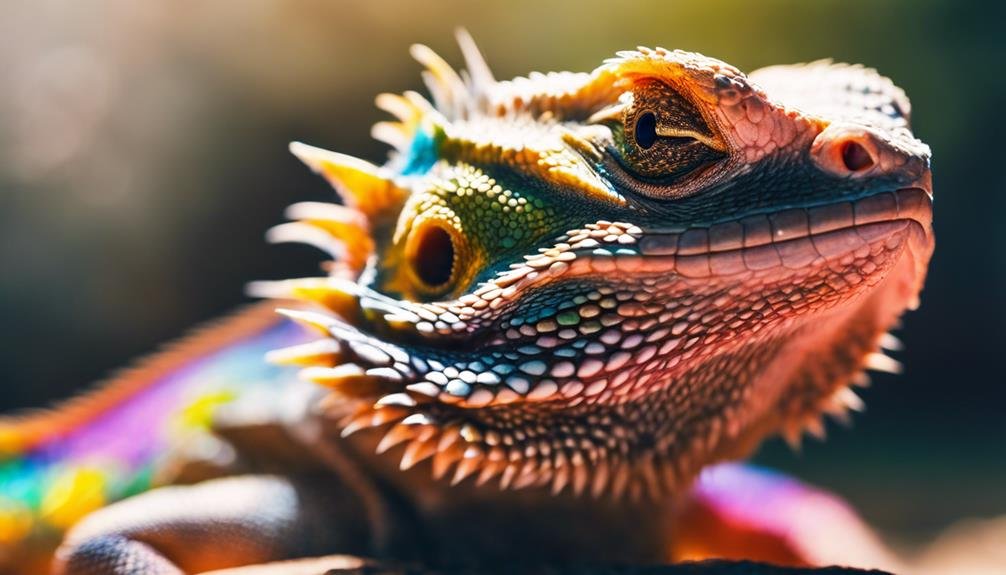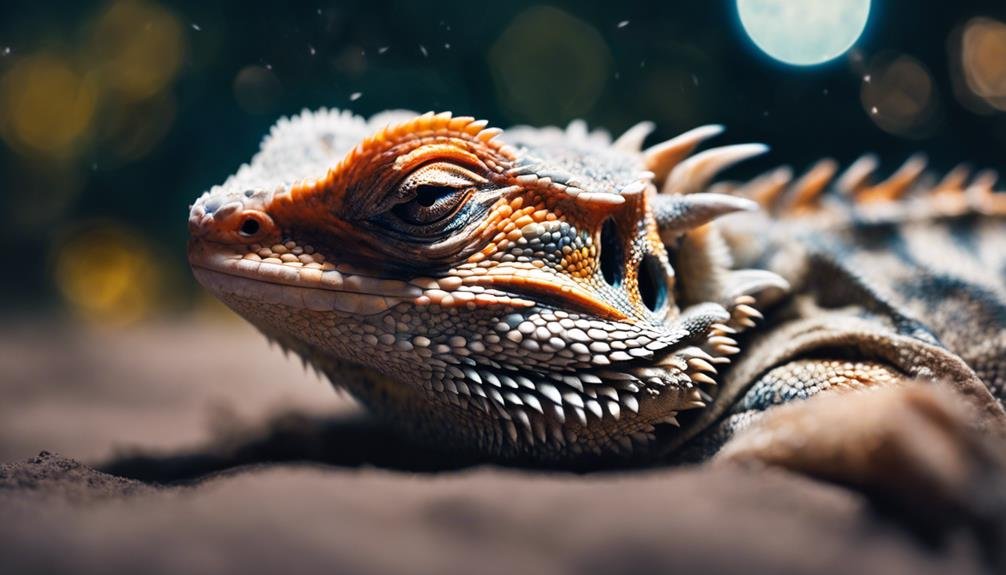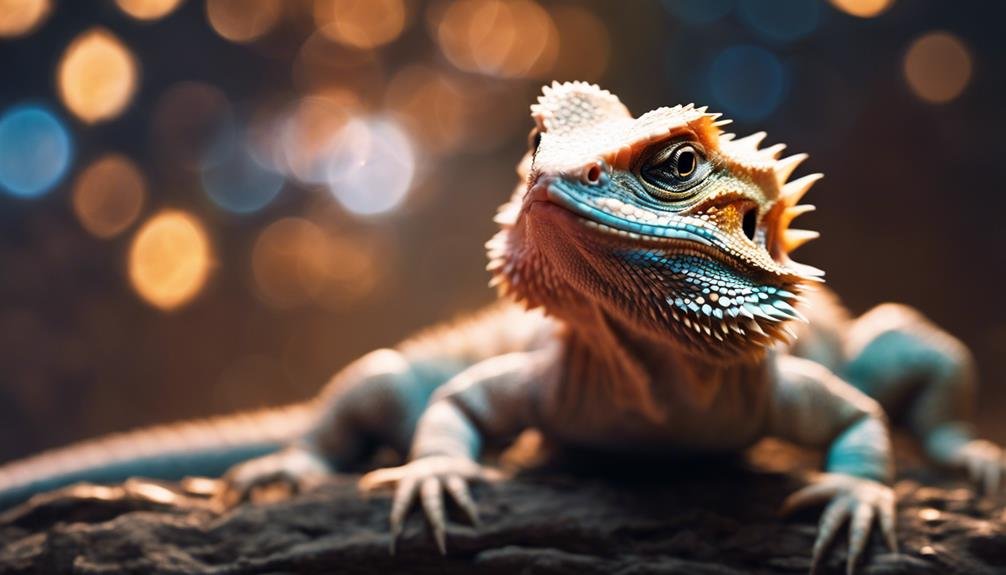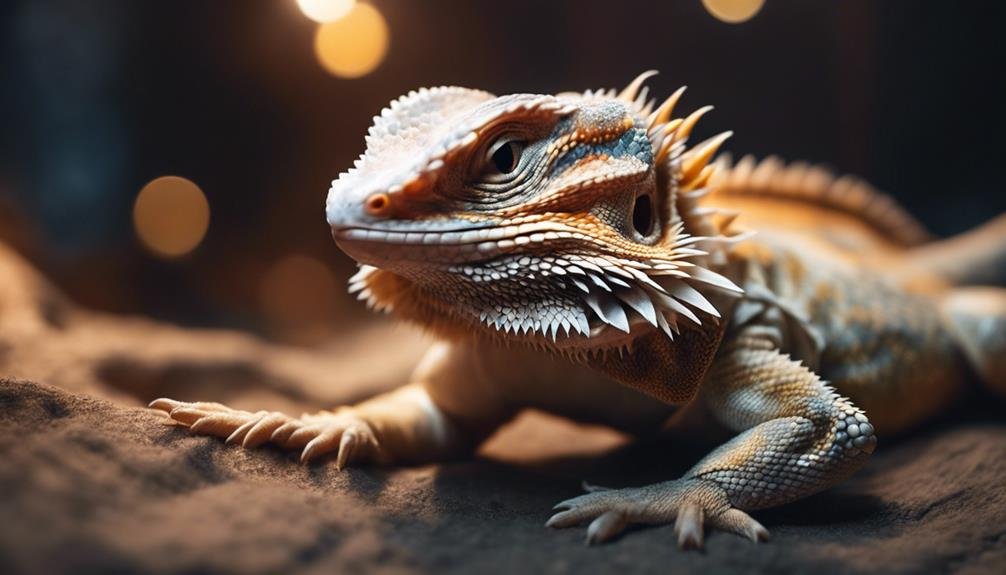You might have heard rumors about bearded dragons possessing a third eye, and yes, they do. This 'magical' eye, technically known as the parietal eye, sits atop their head, serving more than just an ornamental purpose. Connected to the pineal gland, it's vital for detecting light changes, regulating their internal clocks, and even protecting them from aerial threats. But how exactly does this tiny eye influence a bearded dragon's daily life and overall well-being? The intricacies of its functions and benefits are not just fascinating—they're essential knowledge for anyone invested in the care of these unique reptiles. Let's explore the unseen aspects of the parietal eye that underscore its importance in a bearded dragon's survival and comfort.
Key Takeaways
- Bearded Dragons possess a third eye, known as the parietal eye, located on the top of their heads.
- This third eye is photosensitive and aids in regulating their circadian rhythms and hormone production.
- It does not provide detailed vision but helps detect light changes and potential overhead threats.
- The third eye is connected to the pineal gland, playing a key role in their behavior and physiological functions.
- Understanding and monitoring the third eye can enhance care, ensuring a suitable habitat with appropriate light and temperature gradients.
The Parietal Eye Unveiled
Atop a bearded dragon's head sits the parietal eye, commonly known as the third eye, which plays a pivotal role in their survival and well-being. This unique feature, though not an eye in the conventional sense, is essential for your bearded dragon's daily life. It's linked directly to the pineal gland, influencing not just how they respond to changes in light, but also their hormone production, behavior, appetite, and even reproductive cycles.
Understanding the parietal eye's importance goes beyond mere curiosity. It helps you grasp why your pet behaves a certain way, especially in relation to light and dark cycles. The third eye allows bearded dragons to detect the time of day, which is vital for their thermoregulation. This means they rely on it to bask efficiently, ensuring they get enough heat during the day and cool down at night.
Moreover, the parietal eye aids in their defense mechanisms, allowing them to sense predators from above and react accordingly. It's an integral part of their survival toolkit, guiding their circadian rhythms and contributing significantly to their overall well-being. So, when you're observing your bearded dragon, remember the invisible work of the parietal eye—it's keeping them safe, healthy, and happy.
Sensory Functions Explained
Understanding the parietal eye's role, let's explore how it sharpens a bearded dragon's sensory perception of its environment. This unique feature, also known as the third eye, isn't for seeing in the traditional sense. Instead, it's a photosensitive organ that plays an essential role in your bearded dragon's survival. Situated on the top of its head, hidden under scales, the parietal eye helps your pet sense changes in light, shadows, and movements above, alerting it to potential dangers lurking from above.
It's fascinating to think that this tiny organ aids in detecting predators, ensuring the bearded dragon can take evasive action even before the threat becomes visible. This heightened awareness allows your bearded dragon to thrive, not just in captivity but also in the wild, where such sensory advantages are critical for survival. By recognizing the importance of the parietal eye, you'll appreciate the complex nature of your pet's interaction with its surroundings.
Additionally, platforms like TikTok offer a wealth of educational content, allowing you to observe and learn more about the intriguing sensory functions of the bearded dragon's third eye.
Beyond Visual Perception


You've learned how the bearded dragon's parietal eye senses light and shadow, but it's time to explore how it functions beyond just detecting these changes.
This unique organ allows them to sense environmental shifts, playing a critical role in their survival.
Understanding parietal eye functionality can help you better care for your pet by appreciating the nuances of their sensory world.
Parietal Eye Functionality
While the parietal eye of bearded dragons doesn't capture images like their main eyes, it plays an essential role in regulating essential physiological functions beyond mere visual perception.
This unique sensory organ isn't connected to the optic nerve but instead processes information through the pineal gland. It's adept at sensing light, darkness, and particularly UV light, which is critical for regulating their body temperature, hormone production, and even their sleep cycles.
The connection through the pineal gland helps in adjusting melatonin production, which in turn determines the quality and pattern of sleep, essential for maintaining their circadian rhythms.
Unlike their lateral eyes, the parietal eye doesn't contribute to visual acuity but is indispensable for ensuring their physiological wellbeing.
Sensing Environmental Changes
Expanding on its role beyond physiological regulation, the parietal eye equips bearded dragons to detect subtle environmental changes, enhancing their survival capabilities.
This third eye isn't just about seeing in the traditional sense; it's about sensing. Bearded dragons use this unique organ to pick up on shadows, light variations, and movements above them, alerting them to potential threats lurking nearby.
It's a critical survival tool, helping them recognize predators and respond appropriately. The third eye's ability to process information differently from their lateral eyes greatly boosts their awareness of their surroundings.
This heightened sensitivity ensures they're always one step ahead, ready to adapt to changes and maintain their well-being. It's truly a magical eye, offering bearded dragons a distinct advantage in the wild.
The Eye's Appearance
You might find it fascinating that the third eye of a bearded dragon isn't just a myth; it's a tangible feature located on the back of their head.
This subtle, often gray or black speck, though not visible like their other eyes, plays an essential role in their survival.
While you can't see it working, its impact on their daily life, from sensing predators to regulating sleep, is profound.
Location on the Head
Perched atop the bearded dragon's head, the third eye manifests as a subtle, gray or black dot nestled under a scale, just shy of its conventional eyes. This unique feature isn't just for show; it's deeply connected to a gland in the brain, known as the pineal gland. This connection is essential, as it makes the third eye sensitive to light changes, playing a pivotal role in regulating hormone production, behavior, and appetite.
Furthermore, it's not just about internal functions; this eye also aids in detecting shadows and movements above, serving as a crucial defense mechanism against predators lurking from above. So, while it might seem insignificant at a glance, the third eye is an indispensable part of their survival toolkit.
Color and Texture
At first glance, you might miss the bearded dragon's third eye, a subtle gray or black speck nestled at the back of the head, its texture seamlessly blending with surrounding scales.
This discreet marking, despite its small size, plays an important role in your pet's ability to perceive its environment. Unlike the lateral eyes, the third eye lacks an iris and isn't connected to the optic nerve, yet it houses a cornea, lens, and retina.
Its sensitivity to light, darkness, and UV light is essential for regulating the bearded dragon's body temperature, hormone production, and sleep cycle. The color and texture of this parietal eye are designed to be unobtrusive, ensuring it doesn't attract unwanted attention from predators while still serving its essential functions.
Visibility to Humans
Spotting the third eye on a bearded dragon requires a keen eye, as it's usually hidden under a scale and appears as a subtle gray or black speck. To see this elusive feature, consider the following steps:
- Observe carefully: The third eye is small and discreet, making it challenging to spot.
- Check the location: Look at the back of the head, just below the line of the other eyes.
- Be patient: It might take time and multiple observations to finally see the third eye.
- Approach cautiously: Avoid startling your dragon by coming from above; this helps them feel at ease and increases your chance of seeing the third eye.
Interaction With Light
You'll find the third eye of bearded dragons remarkably sensitive to light, essential for detecting any looming threats from above. This sensitivity isn't just about sight; it's deeply connected to a gland that helps the bearded dragon interpret changes in light. This unique ability enables them to sense shadows and movements that might indicate the presence of a predator. The third eye serves as a vital survival tool, acting as an early warning system that alerts them to potential danger.
The third eye's role goes beyond mere detection. It's an aphotosensitive organ specifically designed to pick up on subtle changes in light and shadow. This means that even the slightest movements above them, which could signify an approaching threat, won't go unnoticed. As an owner, observing how this third eye interacts with light can offer fascinating insights into your bearded dragon's natural behaviors and instincts. It's a reminder of the intricate ways in which these creatures have adapted to their environment, ensuring their survival against predators. Understanding this interaction with light not only deepens your appreciation for these reptiles but also highlights the importance of this gland in their daily lives.
Impacts on Sleep Behavior


Understanding how the third eye affects your bearded dragon's sleep can enhance your ability to care for them effectively. This specialized eye, known as the parietal eye, plays a pivotal role in regulating sleep patterns and promoting the well-being of your pet. Here's how:
- Melatonin Production: The third eye connects to the pineal gland, influencing melatonin production. This hormone is essential for maintaining your bearded dragon's circadian rhythms, which dictate sleep-wake cycles. Adequate melatonin promotes they rest well at night.
- Day and Night Differentiation: It aids in distinguishing between day and night. This differentiation is important for establishing consistent sleep patterns, helping your bearded dragon know when it's time to wind down.
- Adjustment to Light Changes: Sensing light variations, including UV light, the third eye helps your bearded dragon adjust to changing light conditions. This adaptability minimizes stress related to light changes, promoting better sleep.
- Predator Detection: Although it's less about sleep and more about safety, the third eye's ability to detect predators indirectly influences sleep behavior by reducing stress levels at night.
Monitoring this third eye's function, potentially through observing behaviors and consulting videos for guidance, can provide valuable insights into your bearded dragon's sleep habits and overall health.
Misconceptions Debunked
Despite common myths, the third eye of a bearded dragon, also known as the parietal eye, does much more than merely detect light. This unique feature is often misunderstood, leading to a myriad of misconceptions that videos related to bearded dragons might inadvertently perpetuate. To clarify, let's debunk these myths with straight facts:
| Misconception | Reality | Impact on Bearded Dragons |
|---|---|---|
| The third eye is capable of detailed vision. | It's sensitive to light changes, not equipped for detailed vision. | Helps in detecting predators and regulating daily rhythms. |
| It serves no real purpose. | Connected to the pineal gland, it influences behavior, appetite, and more. | Essential for thermoregulation and reproductive cycles. |
| Only detects daylight. | Also sensitive to overhead threats, playing a role in survival. | Enhances their ability to react to aerial predators. |
| It's an evolutionary leftover without function. | Actively influences various physiological functions. | Integral to their overall well-being and survival instincts. |
| Can be ignored in pet care. | Understanding its functions can improve care and wellness strategies. | Leads to better care practices and a healthier pet. |
Understanding the third eye's true functions dispels myths and enriches our approach to caring for these fascinating creatures.
Visionary Fun Facts


Having debunked common myths about the bearded dragon's third eye, let's now explore some fascinating facts about this unique feature. You might've wondered how dragons have a third eye and what makes it so special. Here's what you need to know:
- Location and Sensory Function: The third eye, known as the parietal eye, sits atop their head, perfectly positioned to sense changes in light, shadows, and movements above. It's an important survival tool, acting as an early warning system to detect predators.
- Light Sensitivity: Unlike our eyes, the third eye doesn't form images but is highly sensitive to changes in light. This sensitivity helps bearded dragons understand when it's day or night, aiding in their sleep cycles and exposing them to the right amount of sunlight for vitamin D synthesis.
- Predator Detection: This eye plays a significant role in their defense mechanism. It can sense the subtlest movements, including the shadow of an approaching bird, triggering an instinct to flee or hide.
- Learning Opportunity: For owners and enthusiasts, this feature opens up a world of educational content. Platforms like TikTok offer insightful videos and tutorials on the third eye, making learning both fun and engaging.
Related Bearded Dragon Care
To guarantee your bearded dragon thrives, it's important to tailor their environment and care practices to accommodate the unique functions of their third eye. This special eye, the parietal eye, plays a significant role in regulating body functions such as temperature, hormone production, and sleep cycles. It's sensitive to light changes, aiding in detecting predators and adjusting to sudden exposure to UV light.
Understanding the third eye's significance is important for creating a suitable habitat. Make sure your bearded dragon's enclosure has a gradient of light and temperature. This mimics their natural environment, allowing them to regulate their body functions effectively. Monitoring the third eye can also give you insights into your pet's health, stress levels, and behavioral patterns. If you notice any changes, it might indicate a need to adjust their environment or schedule a visit to the vet.
Educating yourself on the third eye enhances your interaction with your bearded dragon, making your care more effective and enriching their life. Always remember, a well-cared-for bearded dragon is a happy and healthy companion.
Is the Third Eye in Bearded Dragons Related to Pinworm Infections?
Bearded dragons can develop a condition called pinworm in bearded dragons. This can sometimes cause the third eye, or parietal eye, to become swollen and infected. Although not directly related, maintaining proper hygiene and seeking veterinary treatment for pinworm infections can help prevent complications with the third eye.
Frequently Asked Questions
Do Bearded Dragons Have Third Eye?
Yes, you've heard right! Bearded dragons do have a third eye, known as the parietal eye.
It's not for seeing the way their two main eyes do, though. Instead, it detects changes in light, helping them sense predators and regulate their body functions.
This special eye sits on top of their head, playing a key role in their behavior and well-being.
Do Lizards Have a 3rd Eye?
Yes, many lizards, including bearded dragons, have a third eye, known as the parietal eye. It's a pivotal evolutionary adaptation that helps them sense predators and changes in light. This eye isn't for seeing images but is vital for survival, alerting them to dangers from above.
Its evolutionary significance lies in its role in enhancing their instincts, making them adept at avoiding threats. Isn't nature's design fascinating?
Do Bearded Dragons Have a Jacobson Organ?
Yes, bearded dragons do have a Jacobson's organ. It's one of their key sensory adaptations, tucked away in the roof of their mouth.
By flicking their tongue, they pick up scents from their environment, which the organ then processes. This helps them identify everything from dinner to danger, including potential mates.
It's essential for moving through their surroundings, making it a critical part of their survival toolkit, enhancing their ability to make critical decisions based on scent.
Why Do Beardies Close One Eye?
You might've noticed your beardie closing one eye at times. This behavior, often referred to as eye signaling, serves various purposes. It helps them focus on specific objects or rest the other eye, reducing visual distractions.
Sometimes, it's a sign of stress or discomfort. Whether they're being handled, in bright light, or feeling threatened, paying attention to when they close one eye can offer insights into their well-being and mood.
Conclusion
Now that you're clued in on the magical third eye of bearded dragons, it's clear how important it's to their survival and well-being.
This parietal eye does more than just detect light; it's crucial in avoiding predators, regulating sleep, and maintaining a healthy lifestyle.
Remember, debunking misconceptions and understanding its functions can greatly enhance your care for these creatures.
So, keep this eye in mind, and you'll be better equipped to make sure your bearded dragon thrives.



[…] bearded dragons with a third eye can learn tricks too. This unique feature, known as the parietal eye, helps them sense light and […]